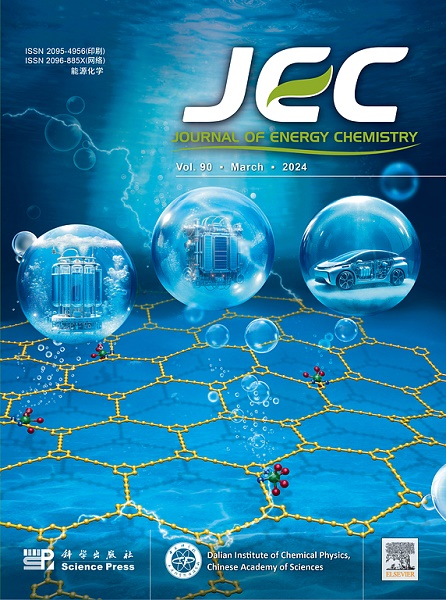Hydrogen spillover effect enhanced Cu2O/Cu/Mn2O3 catalyst for dual-electrode electrocatalytic hydrogen evolution
IF 13.1
1区 化学
Q1 Energy
引用次数: 0
Abstract
Replacing the oxygen evolution reaction (OER) with the anodic formaldehyde oxidation reaction (FOR) is crucial for achieving low-voltage dual-electrode hydrogen evolution. However, existing FOR catalysts face challenges such as low activity, high transition state barriers, and unclear reaction mechanisms. In this study, a three-dimensional nano-composite Cu2O/Cu/Mn2O3 heterogeneous catalyst with enhanced hydrogen spillover effect was synthesized through hydrothermal and photosensitive oxidation treatment techniques. The catalyst consists of ∼20 nm Cu2O/Cu and 30–70 nm Mn2O3 nanoparticles. The hydrogen spillover effect enhanced Cu2O/Cu/Mn2O3 (1:1) electrocatalyst demonstrated outstanding FOR performance, with an anode potential of only 0.128 V at a current density of 100 mA cm−2, significantly lower than that of the Cu2O/Cu-CC catalyst (0.25 V) and the OER potential (1.726 V). Moreover, the Faraday efficiency of the Cu2O/Cu/Mn2O3 (1:1) electrocatalyst reached ∼100%. The electrocatalyst’s FOR performance remains stable over 50 h without decay, and its hydrogen evolution reaction (HER) performance surpasses that of Cu and MnOx electrocatalysts. Density functional theory (DFT) calculations suggested that the Cu2O/Cu/Mn2O3 catalyst significantly lowers the energy barriers for C–H bond breaking (0.48 eV) and H–H bond formation (−0.99 eV) by promoting the hydrogen spillover effect. This study provides theoretical support for designing efficient and stable low-energy dual-electrode hydrogen evolution catalysts and validates their potential through experiments.

求助全文
约1分钟内获得全文
求助全文
来源期刊

Journal of Energy Chemistry
CHEMISTRY, APPLIED-CHEMISTRY, PHYSICAL
CiteScore
19.10
自引率
8.40%
发文量
3631
审稿时长
15 days
期刊介绍:
The Journal of Energy Chemistry, the official publication of Science Press and the Dalian Institute of Chemical Physics, Chinese Academy of Sciences, serves as a platform for reporting creative research and innovative applications in energy chemistry. It mainly reports on creative researches and innovative applications of chemical conversions of fossil energy, carbon dioxide, electrochemical energy and hydrogen energy, as well as the conversions of biomass and solar energy related with chemical issues to promote academic exchanges in the field of energy chemistry and to accelerate the exploration, research and development of energy science and technologies.
This journal focuses on original research papers covering various topics within energy chemistry worldwide, including:
Optimized utilization of fossil energy
Hydrogen energy
Conversion and storage of electrochemical energy
Capture, storage, and chemical conversion of carbon dioxide
Materials and nanotechnologies for energy conversion and storage
Chemistry in biomass conversion
Chemistry in the utilization of solar energy
 求助内容:
求助内容: 应助结果提醒方式:
应助结果提醒方式:


